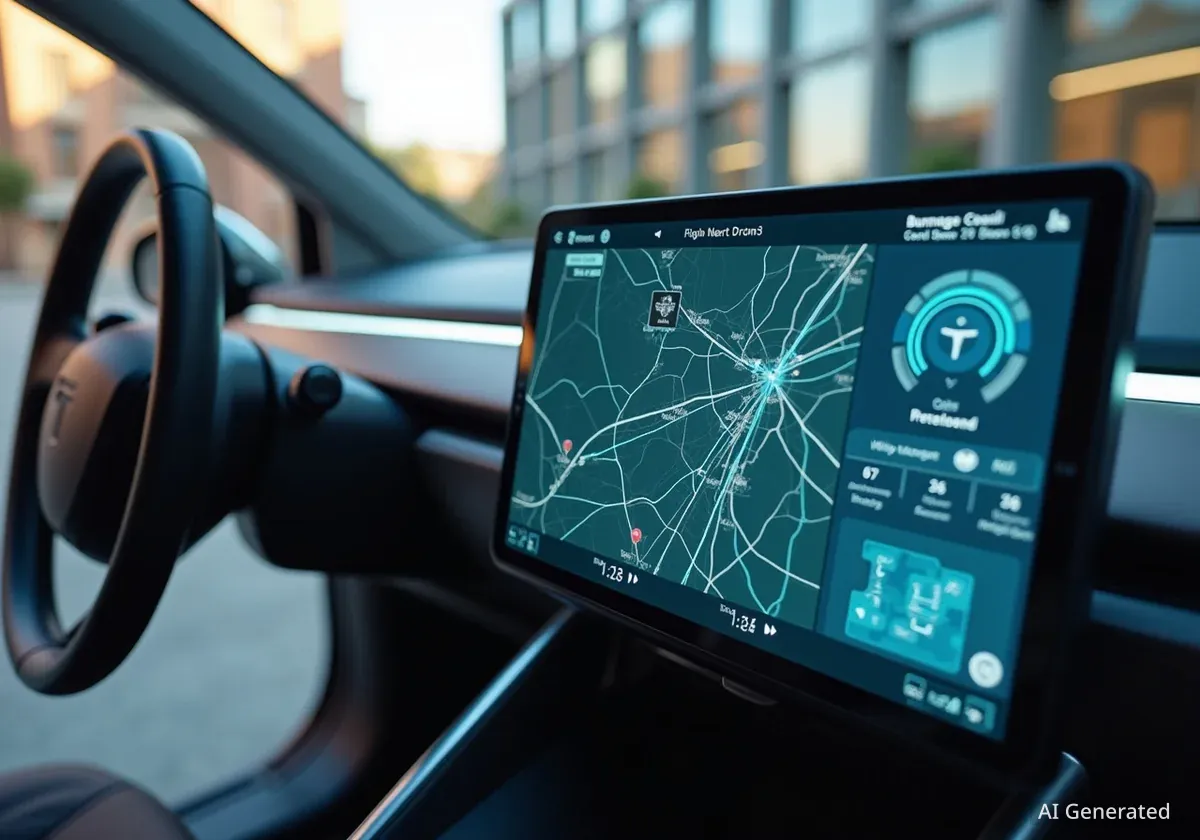Engineers at the University of California, Riverside (UCR) have developed a new diagnostic tool designed to reduce electric vehicle (EV) range anxiety. The system, called State of Mission (SOM), provides drivers with a more practical assessment than a simple battery percentage by determining if the vehicle can successfully complete a planned trip under specific real-world conditions.
Instead of only showing the remaining charge, SOM analyzes factors like elevation changes, traffic, weather, and driving habits to give a clear answer on mission feasibility. This research, aimed at improving driver confidence and vehicle reliability, was recently published in the scientific journal iScience.
Key Takeaways
- Researchers at UCR have created a diagnostic tool called State of Mission (SOM) for EV batteries.
- SOM predicts if an EV can complete a specific trip, considering factors like terrain, temperature, and traffic.
- The system uses a hybrid model that combines machine learning with the physical laws of electrochemistry.
- In tests using NASA and Oxford data, SOM significantly reduced prediction errors for voltage, temperature, and state of charge.
- The technology is being developed for use in EVs, drones, and grid energy storage systems.
Beyond Percentage A New Approach to EV Range
Many electric vehicle owners experience "range anxiety," the fear that their battery will run out of power before they reach their destination. Current battery gauges show a State of Charge (SOC), which is a simple percentage of the remaining energy, similar to a fuel gauge in a gasoline-powered car.
However, an SOC reading can be misleading. A 40% charge might be sufficient for city driving on a flat road but inadequate for climbing a mountain pass in cold weather with the heater on. The UCR team's State of Mission tool was created to address this uncertainty.
What is State of Mission (SOM)?
SOM is a mission-aware diagnostic system. It moves beyond a generic battery percentage to answer a more specific question: Can this vehicle's battery safely and reliably complete a pre-planned journey from point A to point B given the expected conditions?
"It’s a mission-aware measure that combines data and physics to predict whether the battery can complete a planned task under real-world conditions," explained Mihri Ozkan, a UCR engineering professor involved in the project. This shift provides drivers with actionable information rather than just a raw data point.
How the Hybrid System Works
Existing battery management systems typically rely on one of two methods. Some use rigid physics-based equations, which can be accurate but may not adapt well to changing conditions. Others use artificial intelligence models, which can be flexible but often operate as a "black box," making their reasoning unclear.
The UCR team developed a hybrid model that integrates both approaches. It uses machine learning to analyze data from the battery's past performance, such as charging and discharging cycles and temperature fluctuations. This allows the system to "learn" the unique characteristics of a specific battery over time.
"By combining them, we get the best of both worlds: a model that learns flexibly from data but always stays grounded in physical reality," said Cengiz Ozkan, a UCR engineering professor and co-lead researcher on the study.
This grounding in physical reality, based on the principles of electrochemistry and thermodynamics, ensures the model can make reliable predictions even when faced with unexpected events, such as a sudden drop in temperature or an unexpectedly steep incline.
Testing and Performance Results
To validate the effectiveness of the SOM system, the researchers tested it using extensive public datasets from NASA and Oxford University. These datasets included detailed information on real-world battery performance across numerous charge cycles, temperature changes, and voltage variations.
The results showed a marked improvement in accuracy compared to conventional battery diagnostic tools. The SOM system demonstrated significantly lower prediction errors across key metrics.
Key Performance Improvements
- Voltage Prediction Error: Reduced by 0.018 volts
- Temperature Prediction Error: Reduced by 1.37 degrees Celsius
- State of Charge Prediction Error: Reduced by 2.42%
These improvements demonstrate the system's ability to provide a more precise and reliable picture of a battery's true capabilities. "It transforms abstract battery data into actionable decisions, improving safety, reliability, and planning for vehicles, drones, and any application where energy must be matched to a real-world task," Mihri Ozkan added.
Challenges and Future Applications
While the results are promising, the SOM system is still in development. One of the primary hurdles to immediate implementation is its computational requirement. The hybrid model currently demands more processing power than is available in the lightweight computer systems typically used for battery management in today's EVs.
The UCR team is actively working to optimize the software to make it more efficient for integration into existing vehicle hardware. They are confident that these optimizations will allow for its eventual use in production vehicles.
Looking ahead, the researchers see broad applications for the SOM technology beyond passenger cars. The system could enhance the reliability and safety of a wide range of battery-powered technologies, including:
- Unmanned Aerial Vehicles (Drones): Ensuring drones can complete delivery or surveillance missions without power failure.
- Grid Energy Storage: More accurately predicting the capacity of large-scale batteries used to stabilize the power grid.
- Space Missions: Providing reliable power management for rovers and other exploratory equipment.
The team is also exploring how the SOM framework can be adapted for new and emerging battery chemistries, such as sodium-ion, solid-state, and flow batteries. "The same hybrid approach can improve reliability, safety, and efficiency across a wide range of technologies," concluded Cengiz Ozkan.





